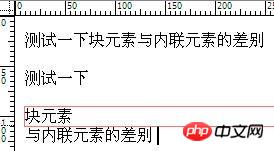<p>测试文字
< ul>
<li>现阶段是不能这样用的,要等到XHTML 2.0才可以这样用。</li>
</ul>
测试文字
</p>Copy after login
而这样又是可以的。
<ul>
<li><p>这样是可以的</p></li>
</ul>Copy after login
为什么呢?因为我们使用的DTD中规定了块级元素是不能放在里面的,再加上一些浏览器纵容这样的写法:
<p>这是一个段落的开始
<p>这是另一个段落的开始Copy after login
当一个签还没结束时,遇到下一个块元素就会把自己结束掉,其实浏览器是把它们处理成这样:
<p>这是一个段落的开始</p>
<p>这是另一个段落的开始</p>Copy after login
所以刚才那样的写法会变成这样:
<p>测试文字</p>
<ul>
<li>现阶段是不能这样用的,要等到XHTML 2.0才可以这样用。</li>
</ul>
测试文字<p></p>Copy after login
这也是跟刚才说第一个例子中里面放
不合理是同一个道理。
那哪些块元素里面不能放哪些块元素呢?我知道你有这个疑问,也知道我仅仅列一张清单你不好记住它们。我们可以先把所有的块元素再次划分成几个级别的,我们已经知道是在最外层,下一级里面只会有、、
 ##In the above example,
##In the above example, 

